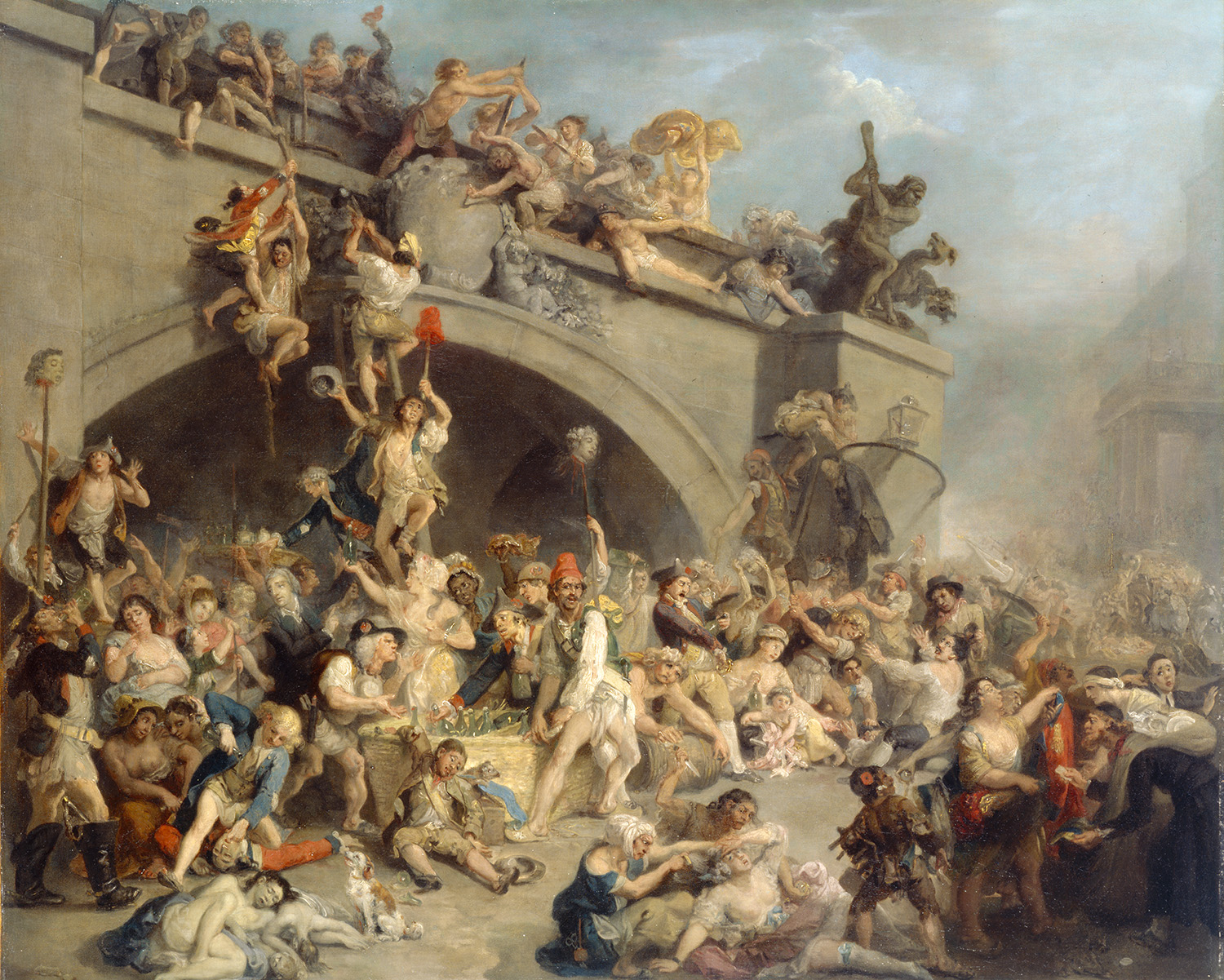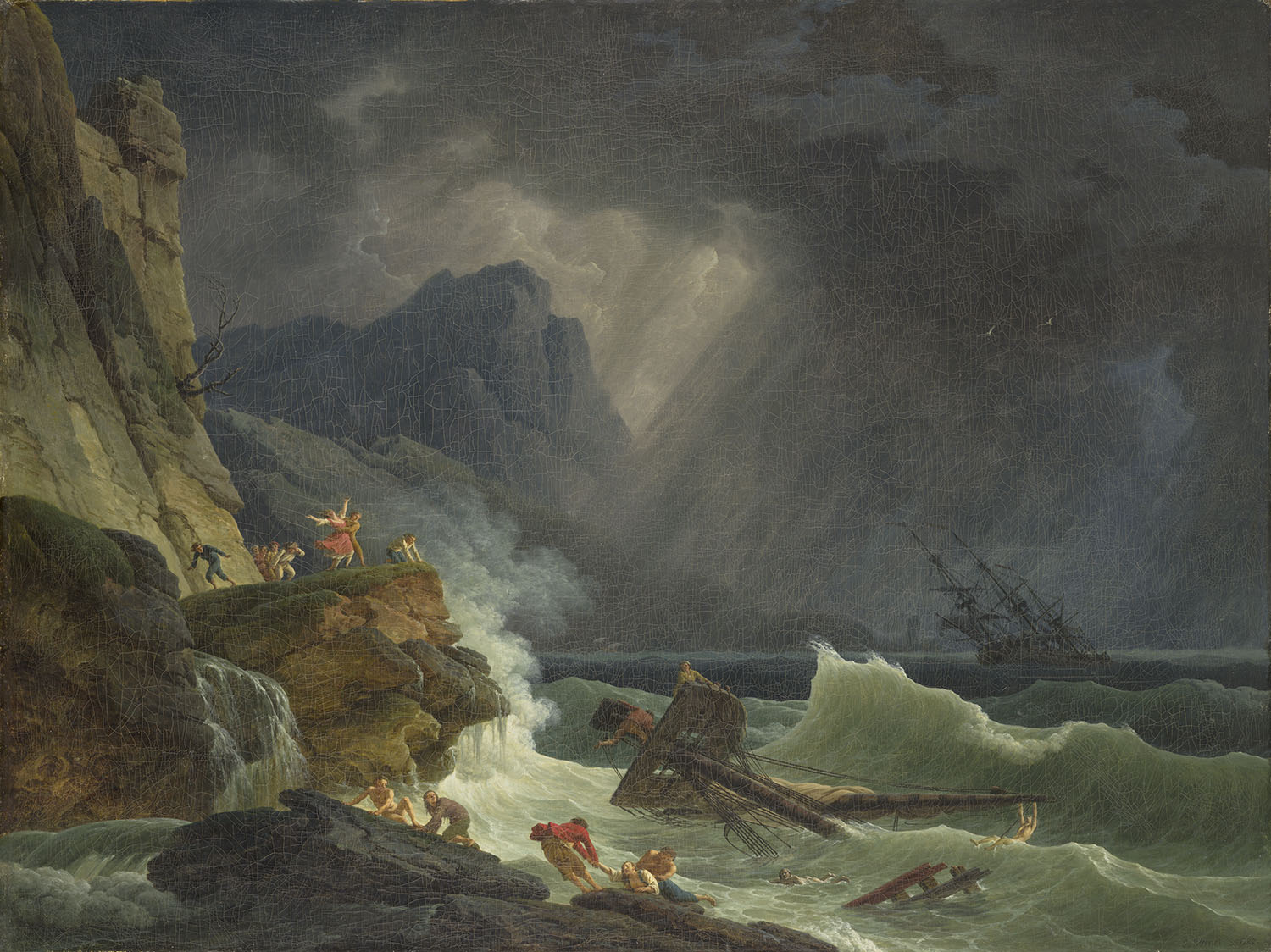12: Mysterious Smile
Amongst all the sitters in art history, the people who sit to have their portrait painted, only a few possess this remarkable skill: to cast the most beautifully perplexing smile, that, with a simple curve of the lips, writes novels of emotional expression. This is one such smile.
Welcome to Accession. Today, we’re at the Wadsworth Atheneum in Hartford, Connecticut. Make your way to the Morgan Court, the large room covered in paintings, and head up to the second floor. If you’ve gone up the grand staircase, with the colored lines on the wall behind you, you can either go left, if you want to start with the Baroque and move forward through history, or to the right, if you want to start with the Impressionists and move backward. Either way, you want to make your way into the room in the back corner, that focuses on France in the late 1700’s: the time of the revolution. In the corner, you should see a woman in a white gown, with a black shawl and a straw hat. And we’re going to take a look at the rest of the room from her eyes, but first, we have to take a look at her. Today, we’re seeing Wadsworth Atheneum, accession number 2002.13, The Duchesse de Polignac Wearing a Straw Hat, by Élisabeth Vigée Le Brun.
Amongst all the sitters in art history, the people who sit to have their portrait painted, only a few possess this remarkable skill: to cast the most beautifully perplexing smile, that, with a simple curve of the lips, writes novels of emotional expression. But of course, it’s not just the sitter whose responsible. The sitter casts the smile. The painter captures it. The viewer is left to read and reread the line until some semblance of meaning can be drawn. You may know of a famous smile or two, who fill entire libraries with their mysteries; But we are looking at a slightly less famous, but infinitely more bewildering smile today, one, that if we are even going to begin to understand it, will require us first to better understand it’s audience, it’s sitter, but most of all, it’s painter.
The painter, of course, needs very little in the way of introduction. She was one of the foremost great painters in the period that bridged the rococo and the neoclassical; a master of her craft, and truly one of the geniuses of her time. But you could guess all that just by looking at the portrait in front of you. I’m talking, of course, about none other than Élisabeth Vigée Le Brun. Starting life as the daughter of an artist certainly helped her along, but Élisabeth Vigée’s genius is the kind that comes from somewhere beyond. While her life was plagued by abusive men, a step-father and husband who would squeeze her for every penny her portraits made, she overcame all of this. She worked her way into the academy that her father belonged to, worked her way into painting for the aristocrats and upper crust of Paris, and worked her way to the top of the group of artists who would define this era of French Painting.
Now it’s certainly true, undeniable, that one of Élisabeth Vigée Le Brun’s greatest strengths was her ability to flatter, to charm. She would make a sitter look not just the way they were, but a little closer to the way they wanted to be. And while this certainly helped her reputation, and helped her gain more of a following, she stood above the rest in her courage when it came to defying convention. For example, in a self portrait with her daughter, Élisabeth painted what, at the time, what was considered unthinkable. She was smiling, with her teeth. It’s a bit passe by our current standards. But in her time, It was the controversy of her art world. But Élisabeth was undeterred by the conventions of her time and painted what she wanted to paint. This kind of brilliance did not go unrecognized, and pretty soon, Élisabeth had attracted the attention of the highest of the nobility in France. But we’ll get to her in a moment.
Next we need to understand the sitter, who probably needs some introduction unless you have an intimate familiarity with the French court of the 1780’s. Her name on the card is the Duchess de Polignac, but those are just the names conferred upon her by her husbands role. When she was born, she was Yolande de Polastron, but those are just the names conferred upon her by her father and his role. Instead, we’ll call her by the name she went by, Gabrielle. Now Gabrielle was not born into the lower class like Élisabeth Vigée; Her family was aristocracy and part of a long, noble lineage. But with the family name came the family debt, a particular kind of debt that plagued families who had been in the aristocracy for some time. And with the name given to her by her husband came the debt of yet another family. And so, Gabrielle did not live a lavish life.
And at this point, I have to tell you something. Something that will, unfortunately, put me on a list of other male historians who have said exactly the same thing about Gabrielle. But if you can, don’t take it from my voice. Take it from the brushstrokes in front of you; Take it from the way the hand delicately holds the flower; Take it from the softness of the cheeks that blend back into the neck; Take it from the hair that twists and turns like a dark cloud behind the face; Take it from her eyes and her smile; Take it from Élisabeth Vigée Le Brun: Gabrielle was beautiful. In fact, she was one of the most beautiful women in all of Paris. And at the age of 26, her sister-in-law invited her to the palace of Versailles, where she would meet the audience of this painting.
The audience, needs little in the way of introduction, but much in the way of understanding. Maria Antonia was born to the emperor of the Holy Roman Empire, which was neither holy, nor roman, nor an empire; and the Empress of the Hapsburg Empire, which was more or less an empire and unmistakably belonged to the Hapsburgs. In a sense, she was doomed from the start. In her world, that meant she would probably be married off to some foreign king in order to settle some treaty or make some peace. And that’s exactly what happened: In 1770, at age fifteen, Maria Antonia crossed the border into France, where she would be the new dauphine and the eventual queen, and as she crossed the border, changed her name to fit the language of her new home. Maria became Marie. Antonia became Antoinette.
Her reign as dauphine and eventually as queen was filled with scandal, and her favor was always mixed amongst the people of France. She was kind, beautiful, spoke and acted as a queen should speak and act. But some French were not interested in the peace her marriage represented, and opposed her simply in opposition to the Austrians. Still others scandalized her marriage, claiming it hadn’t been carried out, questioning the nature of her relationships with the other lords and ladies of her court. She was most widely criticized for her spending, and though it was overblown in the papers, there’s no way to get around the fact that Marie spent a lot of money: She ordered the latest fashions from England for everyone in the court and renovating their homes in the latest styles. To be a member of the court of Marie was to risk putting your family into debilitating debt, just to keep up with the rate of spending. But then, if you were taken from your home at age 15 and sent away to be someone’s wife and queen, you probably would make the most of it as well.
Now these three lives are going to coalesce. In 1770, Le Brun’s reputation will find her as the official court painter for Marie, and working on portraits of Marie with her children to try and help the people of France realize she was a normal person too. And Marie would fight tooth and nail for her husband, the King, to accept Élisabeth into the academy, despite her husband, the abusive one, being an art dealer, which would normally preclude her. And then... in walked Gabrielle.
When Gabrielle came to visit the court of Marie Antoinette, she took the French Aristocracy by storm. Marie was so smitten by her beauty and demeanor that she insisted that Gabrielle move to Versailles. Gabrielle was hesitant, afraid of the further debt it would incur for her family. But Marie immediately found a high ranking job for Gabrielle's husband and absolved all the family debt that plagued her. Marie had to have Gabrielle in her court, and Gabrielle soon became her confidant and closest friend.
The three had come together: the audience, the sitter, and the painter. In 1782, they each played their role in the production of the painting in front of you. Marie commissioned the piece, Gabrielle cast the smile, and Élisabeth captures it perfectly.
On the surface it's just that: A declaration of Gabrielle's beauty. A reminder for Marie of the person who epitomizes what it means to be beautiful, the person who Marie trusted more than any other. But Élisabeth has captured something more here. You can see it in the eyes, and in the smile. It’s not a smile of pure delight. We might stare at this painting on it's own for hours and still not fully grasp the feelings it compels in us. But if we look around this gallery, and look from their eyes, not just Gabrielle's, but from Élisabeth and Marie’s as well, we may find something else here. We'll start to the left and go around the room counterclockwise.
First, Louis XVI, being taken away from his family. There’s Marie, crying. This is it. The beginning of the end. They may have spent extravagantly, they may have not been the best leaders, but the way Brown tells the story we’re meant to weep; to see a family torn apart at the seams.
Then Brutus, tucked in the corner, the founder of the Roman republic; not the one who killed his best friend to overthrow the government, but the one who killed his sons for trying to overthrow the government. We’re meant to realize that revolutions always split families. We may be happy when it splits the families of our enemies, but eventually it will come for our own.
Then Jean-Antoine Roucher. He looks out the window with bravery, dignity, as he is soon to be moved from this prison he’s been kept in, to the guillotine. But this painting is not for him. Hubert Robert painted it for his family, to show them how brave he was, how brave they should be, even though their family was forever broken.
Once the family is broken, the true chaos begins. Zoffany shows us the mobs of humans, bodies, not much more than animals, looting the King's cellars and living in a moment of anarchy. You get the sense that everyone is doing what they want, but no one here is really happy. This is chaos.
Finally the aftermath. Vernet’s Shipwreck. Human structure and social organization has cracked, and sink below to the depths of the ocean, swallowed up by the briny deep. The only thing left is family, the few people, the few bits of humanity you can trust, that you have that help you survive.
At some point during the revolution, Marie Antoinette was taken to the guillotine, but you already knew that. Yolande Gabrielle de Polignac was in exile when she heard of the queens death and died of a broken heart. The only one who made it beyond the shipwreck was Élisabeth Vigée Le Brun, though much more to her own credit than to her families. She lived a life in exile, toured Europe, spent some time in Russia, and eventually made her way back to France, though never staying home for too long. She lived out her days until 1842, always working, always surviving.
Once we’ve made our way around these three walls, we end up back in the time we began in. Before the revolution, before the family broke, before society broke, before family was all we had left, back to a time when a family, one family, was at the center of the society. We can see their china, their salt shakers, their statuettes and busts; the small tokens of their wealth that adorned the halls of the larger tokens of their wealth.
And then we get back to Gabrielle, and Élisabeth, and Marie. And look, once again, at her smile. Her head is turned just to her left, her hat tipped down, as if to look away from the tragedy about to happen on her right, as if to focus on the fine china and statuettes that adorned the life before.
I realize this is just a gallery. This painting was never meant to be situated here amongst these other paintings. And yet, I think the person who has curated this room, they understand precisely what this smile means. It’s 1782. The revolution hasn't happened yet. And maybe Gabrielle and Marie didn't see that. Maybe they think their position was secure.
But Élisabeth Vigée Le Brun? I think she saw it. She started from not much. She worked her way to the top. Shew knew what the people were thinking. And if you look at those eyes, that smile, there is a half-held whimper there; the kind of mourning that gets caught in your throat before there’s really anything to mourn, but when you sense it’s lingering presence.
But Élisabeth captured neither this anxiety nor this beauty in isolation. It’s a statement of assurance. In spite of the blue and grey storm that lingers behind her, in spite of anything else that may happen as you go on in this gallery, in spite of whatever the people’s whispers may bring about in the coming years... Gabrielle will always be beautiful. That cannot, that will not be taken from her. And maybe that's exactly what Marie, concerned with the opinion of the people, needed to see in the smile of Gabrielle, her confidant and closest friend. Élisabeth gives you some comfort in that. She is charming you, just like she always did. That’s what made her a great artist. That is what made her great. That is the genius of Élisabeth Vigée Le Brun.
Sources:
Information on Marie Antoinette and Gabrielle du Polignac came from their respective wikipedia pages. Information on Élisabeth Vigée Le Brun came from her wikipedia page and ArtCurious Episode 3: The Semi-Charmed Life of Elisabeth Vigée Le Brun and Episode 37: Rivals- Vigée Le Brun vs. Labille-Guiard by Jennifer Dasal.
Music:
Siciliene in E Flat Major, by Maria Teresia von Paradis
Trois Sonatas Pour La Harpe by Marie-Elizabeth Cléry
Flute Sonata in F, by Anna Amalia
Special Thanks:
My special thanks this week goes out to Professor DiCenso, my musicology and music history professor, who did much of the leg work in transforming my process for looking at works of art and music from a social and identity narative perspective. He pushed me to be a much better and more critical writer and thinker about the arts. The many classes I took with him shaped my thinking tremendously, and this show would probably just be the "White Guy You've Heard Of" of the week podcast without his part in my education.
Credits:
Our theme music was performed by Mike Harmon, with recording, editing, and mixing from Casey Dawson. Our show art was made by V Silverman. The script is turned into a transcript by Amanda Borglund. This episode was produced, written, recorded, and edited by T.H. Ponders.










